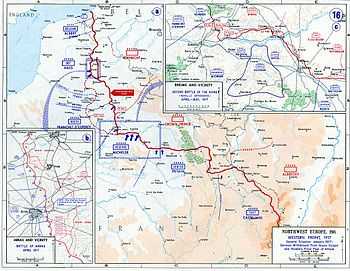Battle of Drocourt-Quéant Line
| Drocourt-Queant Line | |||||||
|---|---|---|---|---|---|---|---|
 German wire at Quéant, 4 October 1918 |
|||||||
|
|||||||
| Belligerents | |||||||
| Commanders and leaders | |||||||
The Drocourt-Quéant Line (Wotan Stellung) was a set of mutually supporting defensive lines constructed by Germany between the French towns of Drocourt and Quéant during World War I. This defensive system was part of the northernmost section of the Hindenburg Line, a vast German defensive system that ran through northeastern France.
Description

The Drocourt-Quéant Line ran between the French cities of Drocourt and Quéant and was part of a defensive system that ran from a point within the Hindenburg Line, eleven miles west of Cambrai, northward to within seven miles west of Douai and terminated along the front east of Armentières.[1] The Drocourt-Quéant Line was a system in depth and incorporated a number of mutually supporting lines of defence. The system consisted of a front line system and a support line system, each consisting of two lines of trenches.[2] The system incorporated numerous fortifications including concrete bunkers, machine gun posts and heavy belts of barbed wire.[2]
Defeat

At 5 AM in the morning on September 2, 1918, the Canadians attacked the D-Q Line supported by tanks and aircraft, during the Hundred Days Offensive, also known as Canada's Hundred Days. In twilight, the Canadian 1st Division attacked the line south-eastwards, on the extreme right, south of the Arras-Cambrai road, The Canadian 4th Division attacked in the centre between Dury and the main road and the British 4th Division attacked south of the River Sensee. The next day the Germans retreated to the Hindenburg Line with the Allies taking many prisoners. The British now moved on to their next objective, the Canal du Nord.
Memorials
The Canadian Dury Memorial commemorates the Canadian Corps' attack on the Drocourt-Quéant Line in 1918.
References
External links
| Wikimedia Commons has media related to Battle of Drocourt-Queant. |